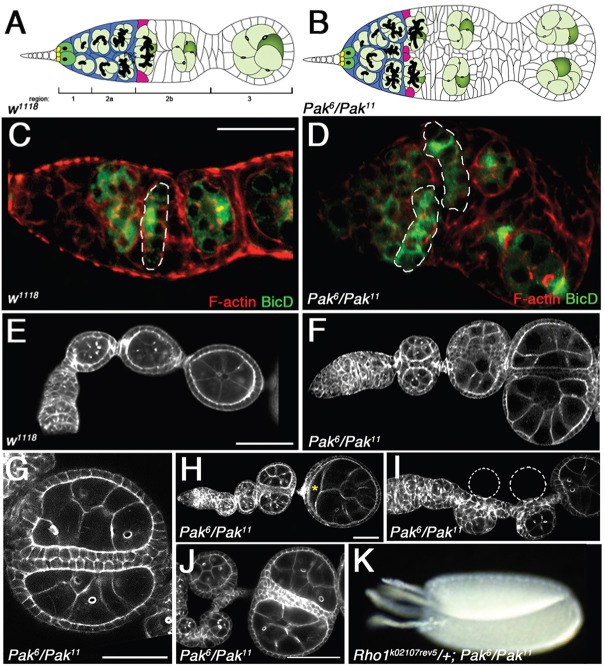Fig. 1.
Pak mutants exhibit a novel side-by-side egg chamber phenotype. Anterior is to the left in all panels. (A) Schematic of a wild-type germarium. In regions 1 and 2a, germline cysts (light green) descended from GSCs (dark green) move through escort cells (blue) to the region 2a/2b border, where they encounter a pair of FSCs (magenta). The FSCs package one cyst at a time into a follicular epithelium (white cells) in region 2b to form egg chambers that bud off in region 3. (B) Schematic of Pak mutant germarium. Region 1/2a is shorter and wider than in WT. Four FSCs package two cysts at a time to form side-by-side paired egg chambers. Samples in panels C-J were stained with FITC-Phalloidin to outline cells. Samples in panels C,D were additionally stained with anti-BicD to reveal germline cysts. (C) Wild-type germarium showing single, flattened cyst at region 2a/2b boundary (dashed line). (D) Pak6/Pak11 germarium showing two flattened cysts at region 2a/2b boundary (dashed lines). (E) Portion of a wild-type ovariole showing a single row of three egg chambers. (F) Portion of Pak6/Pak11 ovariole showing three pairs of side-by-side egg chambers. (G) Close-up view of paired, fused egg chambers in Pak6/Pak11 ovariole, showing that each egg chamber is encapsulated in its own monolayer of follicle cells. (H) Pak6/Pak11 ovariole showing unpaired egg chamber, followed by two pairs of younger, paired egg chambers. Asterisk marks mispositioned oocyte in the unpaired egg chamber. The oocyte is frequently mispositioned in Pak mutant ovarioles bearing paired egg chambers. (I) Pak6/Pak11 ovariole showing unpaired egg chamber, followed by two younger, unpaired egg chambers on one side of an aberrant stalk. Dashed circles indicate positions of ‘missing’ partner egg chambers. (J) Portion of Pak6/Pak11 ovariole showing paired egg chambers, followed by three younger, unpaired egg chambers positioned on alternating sides of an aberrant stalk. (K) Side-by-side fused eggs, each with a pair of dorsal appendages, from rhok02107rev5/+; Pak6/Pak11 female. Scale bars: 25 µm in C,D; 50 µm in E-J.

